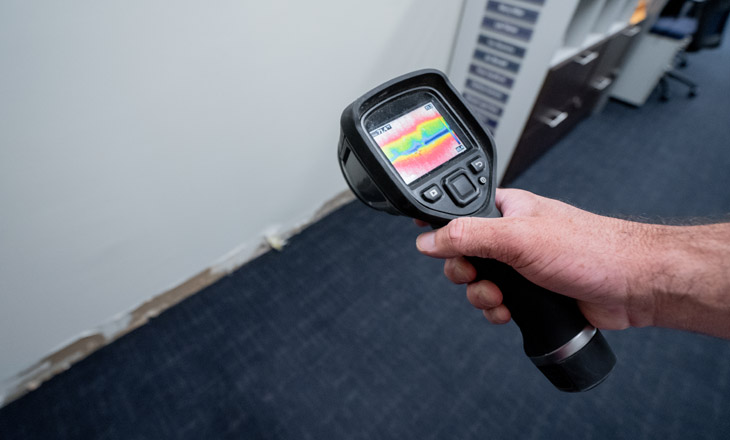Comprehensive Guide to Water Leak Detection for Property Owners and Services
Comprehensive Guide to Water Leak Detection for Property Owners and Services
Blog Article
Cutting-edge Solutions for Early Discovery of Water Leaks in Structures and Facilities
From sophisticated leakage discovery modern technologies to the deployment of IoT sensing units for real-time tracking, the landscape of leakage avoidance is advancing swiftly. Automated water flow evaluation systems are improving exactly how leakages are recognized and resolved, paving the method for a positive approach to water leak detection.
Advanced Leak Detection Technologies
Advanced leak discovery modern technologies, equipped with advanced sensors and algorithms, play a vital duty in promptly recognizing and pinpointing water leaks in various setups. These modern technologies use a mix of acoustic, thermal, and electro-magnetic sensing approaches to detect leakages properly. Acoustic sensors discover the sound of leaving water, permitting accurate localization of the leak resource. Thermal imaging spots temperature adjustments created by water leakage, providing an additional efficient method for leakage recognition. Electromagnetic sensing units can recognize modifications in electromagnetic areas triggered by water, supplying yet an additional layer of leak discovery ability.

IoT Sensors for Real-Time Monitoring
In the realm of contemporary water leakage detection, the integration of IoT sensors for real-time surveillance stands for a critical improvement in improving positive leak detection capacities. These sensing units offer continuous tracking of water systems, supplying real-time information on water circulation rates, pressure variations, and temperature changes. By leveraging IoT innovation, these sensing units can detect even the smallest anomalies in water usage patterns, allowing early identification of prospective leakages prior to they rise right into significant concerns.
IoT sensing units send information to a central system, where innovative formulas evaluate the details and produce signals or notifications when abnormalities are detected. This real-time monitoring capability allows homeowner or center managers to quickly deal with leaks, reducing water damage, reducing fixing prices, and preserving water sources.
Moreover, IoT sensors can be integrated with building monitoring systems, permitting automatic reactions to spotted leaks, such as shutting down water shutoffs or activating pumps to minimize the impact of leaks. In general, the execution of IoT sensing units for real-time surveillance significantly enhances the efficiency and performance of water leakage detection in why not try this out structures and facilities.
Artificial Intelligence Algorithms for Leak Forecast

One key advantage of making use of artificial intelligence for leak forecast is its capacity to continuously find out and boost its precision in time. As even more data is collected and fed right into the algorithm, it can refine its forecasts and adapt to transforming conditions, inevitably boosting the reliability of leakage detection systems.
Additionally, device learning formulas can help in determining subtle indications of leaks that might go undetected by typical tracking methods. water leak detection. By examining complex information collections in real-time, these algorithms can give early cautions and notifies, permitting prompt treatment and preventive upkeep to mitigate prospective water damages and linked expenses
Making Use Of Thermal Imaging for Leak Discovery
Thermal imaging technology offers an encouraging strategy for identifying water leaks in different systems and facilities. By using infrared radiation and temperature level differences, thermal imaging cameras can identify covert leaks that are not conveniently noticeable to the nude eye.
One of the crucial advantages of thermal imaging for leakage click to read more detection is its non-intrusive nature. Generally, the use of thermal imaging technology improves the efficiency and precision of water leak discovery, making it a useful tool for keeping the honesty of structures and infrastructures.
Automated Water Circulation Analysis Equipments
How can computerized water flow analysis systems reinvent the discovery and administration of leaks in different systems and infrastructures? Automated water circulation analysis systems supply a proactive strategy to leak discovery by continuously checking water circulation prices and patterns. By establishing standard data, these systems can swiftly identify variances that may show a leak, allowing prompt intervention to protect against comprehensive damages.
These systems utilize sophisticated algorithms to examine real-time information and offer instant signals when anomalies are identified, permitting swift action to be taken. Furthermore, computerized water flow analysis systems can be integrated with structure monitoring systems or IoT platforms, enhancing overall performance and making it possible Learn More Here for remote monitoring capacities.
In addition, the information accumulated by these systems can be made use of for anticipating upkeep objectives, aiding to recognize possible weak factors in the framework prior to leaks happen. Generally, the implementation of automatic water flow analysis systems can dramatically improve leak detection and monitoring techniques, eventually causing cost savings, minimized water wastage, and raised sustainability in structures and framework.

Verdict
Finally, the integration of sophisticated leak detection innovations, IoT sensing units, maker understanding algorithms, thermal imaging, and automated water flow evaluation systems offers innovative solutions for early discovery of water leaks in buildings and facilities. These innovations allow real-time tracking, prediction of leaks, and efficient discovery approaches to avoid water damage and waste. Carrying out these solutions can assist in preserving the stability and sustainability of water systems in various setups.
Report this page